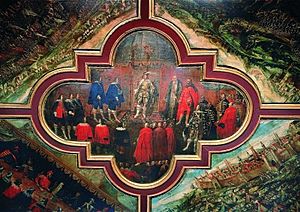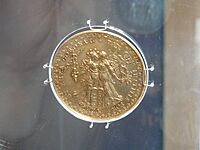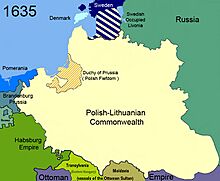Treaty of Stuhmsdorf facts for kids

Treaty of Stuhmsdorf, wall painting from Kielce Castle. Visible: bishop and chancellor Jakub Zadzik, Polish king Władysław IV and Hetman Stanisław Koniecpolski.
|
|
| Type | Ceasefire |
|---|---|
| Signed | 2 (O.S.)/12 (N.S.) September 1635 |
| Location | Stuhmsdorf/Sztumska Wieś, Poland |
| Parties | |
The Truce of Stuhmsdorf (also known as Sztumska Wieś) was an important agreement. It was signed on September 12, 1635. This treaty brought a halt to fighting between the Polish–Lithuanian Commonwealth and the Swedish Empire. The signing happened in a village called Stuhmsdorf, which is now Sztumska Wieś in Poland.
This agreement created a truce (a temporary stop to fighting) that lasted for 26 and a half years. Sweden was tired from being involved in the Thirty Years' War. Because of this, they agreed to terms that were mostly good for the Commonwealth. The Commonwealth got back many lands it had lost in earlier wars with Sweden.
The truce also helped Sweden and its friends like France, England, and the Dutch Republic. They wanted Sweden to focus on the Thirty Years' War in the Holy Roman Empire. This way, Sweden would not have to worry about fighting Poland at the same time. The truce lasted until 1655. At that time, Sweden invaded the Commonwealth, starting the Second Northern War.
Contents
Why the Truce Was Needed
This section explains why both sides wanted to make a deal.
Poland's Situation and Goals
The Polish–Lithuanian Commonwealth had different ideas about what to do. King Władysław IV Vasa of Poland wanted to get back the Swedish crown. His father, Sigismund III Vasa, had once been king of Sweden but lost the throne. Władysław also wanted to become more famous and stronger in the Commonwealth. The Commonwealth's "Golden Liberties" meant the king had less power than in other European countries.
Władysław thought a war could help him achieve his goals. He believed the Commonwealth could gain more by fighting Sweden. But he was also open to a peaceful solution if it gave him what he wanted. He hoped to trade his claim to the Swedish crown for permanent control over some lands.
Many of his noble advisors (called the szlachta) were not sure about continuing the war. However, many agreed that Sweden should leave Poland. They preferred talks but were ready for war if needed. Few nobles wanted to fight just to help Władysław become king of Sweden again. There was often disagreement between those who wanted to make the king stronger and those who feared losing their own power.
Sweden's Challenges and Aims
Sweden and its allies had recently faced problems in Germany. They lost the Battle of Nördlingen. Also, the Electorate of Saxony switched sides. This made Sweden's position weaker in negotiations.
However, the Swedes knew that the lands they had taken in Germany were harder to defend. The lands they captured from the Commonwealth in Prussia and Livonia were easier to hold. So, they preferred to give up German lands rather than Prussian ones. They were willing to leave Prussia if Władysław gave up his claim to the Swedish crown. But they wanted to keep their lands in Livonia.
Sweden's government also had its own problems. There was a power struggle between Chancellor Axel Oxenstierna and his opponents. Some of these struggles led to information leaks, which helped the Polish side.
Other Countries Get Involved
Many European countries were interested in these talks. They were also named as mediators (helpers in reaching an agreement) in an earlier truce from 1629 called the Truce of Altmark. This gave them many chances to influence the talks between Poland and Sweden.
France, England, and Netherlands
Cardinal Richelieu of France wanted peace between Poland and Sweden. He aimed to weaken the Holy Roman Empire. He planned to use Sweden and German Protestants to keep Germany divided and fighting. For this to work, Sweden needed to stay in the Thirty Years' War. So, Richelieu wanted to make sure Poland stayed neutral. He did not want Poland to open a new front in Prussia. He sent one of his trusted negotiators, Claude d'Avaux, to help.
The Dutch and English ambassadors at the meeting supported France's efforts. They also offered a lot of money to speed things up. England sent Sir George Douglas to support Władysław. There were even talks about Władysław marrying an English princess, but this did not happen.
Brandenburg-Prussia's Role
George William, who was the Duke of Prussia and a Prince-elector of Brandenburg, wanted a peaceful solution. He did not want his lands to be damaged by more fighting. His Duchy of Prussia had not helped Poland in a war, which it was supposed to do as a vassal. Because of this, George William's rule in Prussia was put on hold. The Polish king replaced him with a viceroy, Jerzy Ossoliński.
Starting the Negotiations
The talks began on January 24, 1635. They took place in a Prussian village called Preussisch Holland (Pasłek). The Polish negotiators were led by Bishop and Chancellor Jakub Zadzik. The Swedish negotiators were led by Per Brahe the Younger.
The first talks did not go well. Both sides tried to delay things. They argued about their rulers' titles. They also waited for most of the international mediators to arrive. Only Brandenburg was there at first. The Swedes thought delays would help them. But Władysław used their refusal to negotiate to get support from the Polish parliament (the Sejm).
With support from some powerful nobles, the Sejm agreed to new, large taxes. Even before the vote, Władysław had gathered a new army of about 21,000 soldiers. He also bought ten ships to turn into warships.
Later Talks and Agreement
In the months between the first talks and the Stuhmsdorf negotiations, Sweden's military and political situation got worse. They suffered more defeats, and more allies left them. The Swedes became more willing to discuss leaving Prussia. They were also more careful about fighting Poland. By the end of March, they were ready to accept most of Poland's demands.
On May 24, negotiations started in Stuhmsdorf. The Polish negotiators stayed in nearby Jonasdorf (Jankowiec), and the Swedes in Marienwerder (Kwidzyń). Foreign mediators arrived. Jacob De la Gardie joined the Swedish team. On the Polish side, Jakub Sobieski replaced Krzysztof Radziwiłł.
After about a month and a half, the idea of a full peace treaty was dropped. Instead, the Swedes suggested leaving all of Prussia for a 50-year truce. This would happen if Władysław gave up his claim to the Swedish crown.
Both the Polish nobles (magnates) and the local representatives (from sejmiks) saw no reason to fight. Sweden was offering good terms without any bloodshed or trade losses. These losses would surely happen if they kept fighting. They also remembered the costs of recent wars against Russia and the Polish–Ottoman War (1633–1634). There was also unrest in the southeastern parts of the country. Occasional raids by Tatars, supported by the Ottomans, needed many Polish soldiers.
Władysław had gathered many soldiers and twelve ships. He was disappointed to find that almost no nobles supported the war anymore. He had gained almost nothing for himself from the treaty. Still, his advisors eventually convinced him to sign the agreement.
The treaty was a partial disappointment for Sweden's Chancellor Oxenstierna. He had hoped Sweden would not have to give up so much. But he did succeed in keeping Sweden involved in the war in Germany. This was despite many calls from the Swedish parliament (Riksdag) to pull all Swedish forces out of that area.
George William's wish for a settlement that gave him full control of Ducal Prussia won out. The Treaty of Stuhmsdorf left Brandenburg fully in possession of Ducal Prussia. However, it also freed up Swedish troops. These troops had been occupying Prussia and Livonia. This meant that Mecklenburg and Pomerania came under Sweden's power. The treaty also made it harder for the House of Hohenzollern to get Pomerania. This was seen as a political mistake by George William. His short-term gains were outweighed by his long-term losses.
What the Treaty Said
The treaty was signed on September 12. It created a truce for 26 and a half years. This truce was an extension of the earlier Truce of Altmark.
Here are the main points:
- The Swedes kept the Duchy of Livonia north of the Daugava River and the city of Riga. But they had to let Catholics there practice their religion freely.
- The Swedes had to return the lands they had taken in Baltic Prussia. These included Elbing (Elbląg), Memel (Klaipėda), and Pillau (Baltiysk). The last two went back to George William, Elector of Brandenburg. Sweden also had to remove their soldiers from these places.
- The Swedes gave up their right to collect taxes (tariffs) on Polish trade. This tax was 3.5% on goods passing through Baltic Sea via Danzig (Gdańsk). This tax had been a big problem for the nobles (szlachta). The grain trade through Danzig was a major source of their income.
- The Swedes also had to return the ships they had taken from the Commonwealth Navy. However, the Commonwealth Navy was not allowed to help Sweden's enemies.




